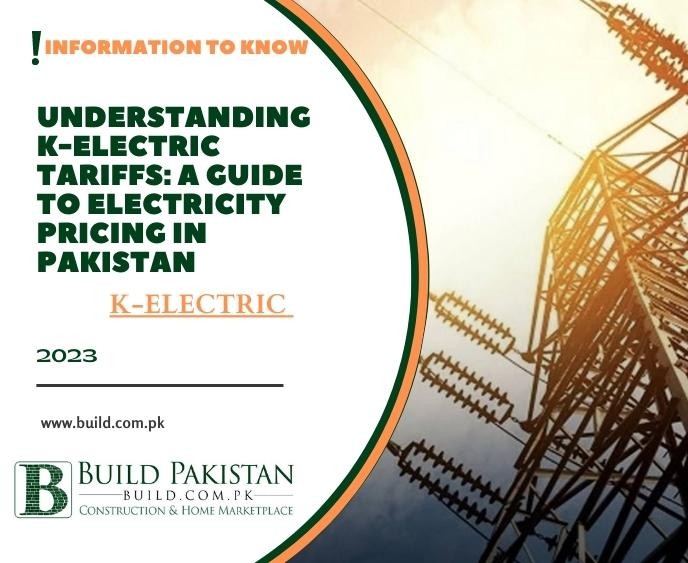Understanding K-Electric Tariffs: A Guide to Electricity Pricing in Pakistan

Introduction:
Electricity is an essential resource that
powers our daily lives, and understanding the tariffs associated with it is
crucial for managing energy costs effectively. In Pakistan KElectric is one
of the major electricity providers supplying power to the city of Karachi. In
this blog post, we will explore the concept of K-Electric tariffs, discuss the
factors that influence electricity pricing, highlight the different tariff
categories, and provide insights to help you navigate and optimize your
electricity usage while considering K-Electric tariffs.
Understanding K-Electric Tariffs:
K-Electric tariffs refer to
the pricing structure set by the utility company for supplying electricity to
its customers. These tariffs determine the rates charged for electricity
consumption based on various factors, such as the type of customer
(residential, commercial, industrial), energy consumption levels, and time of
usage. The tariff structure ensures fair and sustainable pricing while covering
the costs of electricity generation, transmission, and distribution.

Factors Influencing K-Electric Tariffs
Several factors
influence the determination of K-Electric tariffs in Pakistan:
Fuel Costs:
The cost of fuel, such as natural gas or furnace
oil, used in electricity generation plays a significant role in determining tariffs.
Fluctuations in fuel prices can impact the overall tariff structure.
Generation Capacity and Demand:
The availability of
electricity generation capacity and the demand-supply dynamics influence tariff
rates. During times of peak demand, tariffs may be higher to manage the
increased load on the grid.
Infrastructure Costs:
The cost of maintaining and upgrading
infrastructure, including power plants, transmission lines, and distribution
networks, is considered in the tariff structure.
Government Policies:
Government regulations and policies
related to the energy sector, such as subsidies or taxes, can affect the
tariffs set by K-Electric.
Distribution Losses:
Technical and commercial losses incurred
during electricity distribution impact the overall cost which are reflected
in the tariffs.
Types of K-Electric Tariffs
Residential Tariffs:
Residential tariffs are designed for
households and include different rate slabs based on monthly consumption
levels. Typically, higher consumption levels result in higher tariff rates.
Commercial Tariffs:
Commercial tariffs apply to businesses
and commercial establishments. They are structured differently from residential
tariffs and often have separate rate slabs based on the type of business and
electricity consumption patterns.
Industrial Tariffs:
Industrial tariffs are specific to
industrial consumers and are designed to meet their unique energy requirements.
These tariffs may vary depending on the industrial sector, energy demand, and
power factor.
Time of Use (TOU) Tariffs:
TOU tariffs offer different rates
based on the time of day and the season. Peak hours, typically during the
evening, may have higher tariffs while off-peak hours may have lower rates to
incentivize energy consumption during non-peak periods.
Optimizing Electricity Usage under K-Electric Tariffs
To
optimize your electricity usage and manage costs under K-Electric tariffs,
consider the following:
Energy Conservation:
Implement energy-efficient practices and
use energy-saving appliances to reduce consumption and lower your electricity
bills.
Load Management:
Distribute your electricity usage evenly
throughout the day, especially during peak hours, to avoid higher tariff rates.
Consider shifting energy-intensive tasks to off-peak hours.
Demand Response Programs:
Explore any demand response
programs offered by K-Electric that provide incentives for reducing electricity
usage during times of high demand.
Renewable Energy Solutions:
Consider integrating renewable
energy sources, such as solar panels, to supplement your electricity needs and
potentially reduce reliance on the grid.
Conclusion:
Understanding K-Electric tariffs is essential for
managing electricity costs effectively and optimizing energy usage. By
familiarizing yourself with the tariff structure, factors influencing pricing,
and implementing energyefficient practices, you can make informed decisions to
control your electricity expenses. Stay updated with K-Electric's tariff
revisions, explore opportunities for renewable energy adoption, and adopt smart
energy management practices to ensure efficient and cost-effective electricity
consumption.









